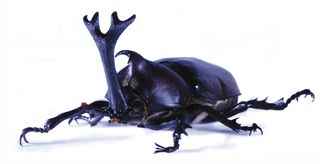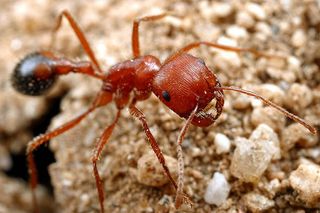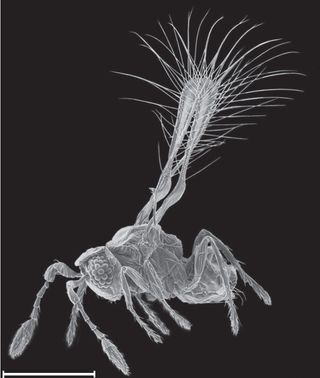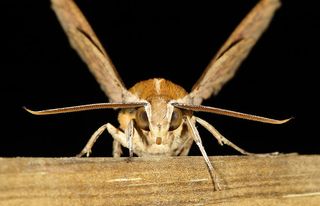20 Startling Facts About Insects
Almost everywhere you look, you'll find one — or dozens — of the six-legged critters called insects. A wildly diverse bunch, the class Insecta includes ants, bees, flies, beetles and much more. These creatures all possess a body composed of three segments — head, thorax and abdomen — encased in a hard exoskeleton. All insects also sport a pair of antenna, compound eyes and three pairs of jointed legs. From that basic body plan, emerge all sorts of amazing behaviors and abilities, as Live Science reveals here in 20 startling facts about insects.
1. The most successful creatures. To date, scientists have catalogued about 1.5 million species of organisms on the planet, with insects making up about two-thirds of this bounty, researchers report in the journal Proceedings of the National Academy of Sciences. But scientists have only begun to scratch the surface: Studies estimate the total number of species on Earth is probably closer to 9 million. Of the planet's wildly diverse collection of creatures, some 90 percent of species are reckoned to belong to the class Insecta. Reasons for insects' success include their tiny size, which both makes hiding easier and reduces overall energy requirements; wide diet of both natural and artificial foods; tough, protective exoskeletons; frequent possession of wings, which help them reach safety, grub and mates; and prodigious ability to reproduce.

2. Meet the beetles. Beetles, of the insect order Coleoptera, are the most biodiverse group of creatures known, with more than 380,000 species described to date, making up 40 percent of all insect species on the books. When asked what a study of nature tells you about a creator, the British scientist J.B.S. Haldane once reportedly quipped that you can assume such a creator has "an inordinate fondness for beetles." A recent Proceedings of the Royal Society B study suggests the secret to beetle diversity, and likely to that of other insects groups, is their lifestyle versatility. This ensures that their species do not go extinct as readily as, say, mammal or amphibian species.

3. Planet of the ants. Outside in warm temperatures? If so, when you look down you'll probably spy an ant or two or 10 scurrying along. (It's not uncommon to see ants when indoors, either.) The renowned biologists Bert Hölldobler and E. O. Wilson estimated in their Pulitzer Prize-winning 1990 book, "The Ants" (Belknap Press), that on the order of 10 quadrillion ants live on the planet at any given moment. That's about 1.4 million ants per human, based on a world population of 7.3 billion people.
4. On every continent . . . but just barely. Although insects can be found by the buckets just about anywhere on Earth, there's one continent where they barely have a foothold: Antarctica. In fact, only one true species of insect, a wingless midge called Belgica antarctica, calls the southernmost continent home, according to the Laboratory for Ecophysical Cryobiology at Miami University (Ohio). The tiny fly is only 0.08 to 0.23 inches (0.2 to 0.58 centimeters) long, but it's still the Antarctic's largest terrestrial animal. Amongst this insect's many ingenious adaptations to Antarctic harshness, B. antarctica can withstand the freezing of its bodily fluids and sports a rich, purple-black complexion to soak up as much visible sunlight as it can for warmth.
5. Landlubbers. Seeing as you still can't escape insects even in Antarctica, there is one place where you can go to be virtually free of the six-legged creatures. That place is the 70 percent of the Earth's surface covered by the ocean. Why have insects failed to set up shop in the biggest biosphere on the planet? No one really knows why, but suggested explanations are that the oceans lack the plants for food and sheltering habitat that are found on land. Another possible explanation is that a cousin of insects, the crustaceans, have largely made the ocean their home, potentially muscling out their jointed-leg competitors.
6. Breathing through their sides. Insects do not breathe through their mouths. They inhale oxygen and exhale carbon dioxide via holes called spiracles in their exoskeletons. These holes typically line insects' thoraxes and abdomens. Also bizarre: Insect respiratory systems are not patched into the animals' circulatory systems, as they are in humans, where the lungs exchange gases with the bloodstream. Instead, insects have a cardiovascular-like network of tubes, called a tracheal system, which delivers oxygen and ferries away carbon dioxide from each cell in the animals' bodies.
Sign up for the Live Science daily newsletter now
Get the world’s most fascinating discoveries delivered straight to your inbox.
7. Blood bath. Speaking of circulatory systems, insects' are way different from humans'. Rather than closed vessels such as arteries and veins shuttling blood around, insects have an open circulatory system, in which their blood, called "hemolymph," bathes the organs. The insect "heart" is a segmented and chambered vessel running along the animal's back. This vessel contracts to send hemolymph forward toward the head; from there, it sloshes around back into the rest of the body. Hemolympyh is typically clear but can be greenish or yellowish, as anyone knows who has seen certain bugs splatter on their windshield or underfoot.
8. Ancient critters. The oldest insect fossil — a set of jaws, actually — goes back 400 million years, suggesting insects were among the first animals to transition from sea to land. Insects, in other words, were around a good 170 million years before dinosaurs came onto the scene.
9. That's a big bug. The largest insect ever known to have terrorized the skies is Meganeuropsis, or the griffinfly, which was an ancient dragonfly with a wingspan of up to 2.5 feet (0.8 meters). These ancient dragonflies preyed on other insects and small amphibianlike creatures during their reign from about 290 million to 250 million years ago.

10. Monsters and motes. The heftiest insect found today is New Zealand's giant weta, a cricketlike beast that can weigh more than a pound. The longest insect, meanwhile, is Chan's megastick, native to the island of Borneo and stretching over 22 inches (66 cm). The smallest insect, you ask? The evocatively named fairyflies from Costa Rica. In one of these wasp species, Dicopomorpha echmepterygis, the male is a mere 0.005472 inches (0.014 cm) long.
11. I see you . . . and you, and you, and you, and you! A prominent feature on insects is the compound eye, consisting of many individual visual units called ommatidia. A popular misconception (promulgated tongue-in-cheek in this section title) is that each unit acts as its own eye, each perceiving a total field of view. But in fact ommatidia act more like pixels, building up into a mosaic of imagery. The dragonfly is widely considered to have the most impressively ommatidia-studded compound eyes, with about 30,000 units per half-spheroid eye, according to researchers reporting in a 2012 issue of the online journal PLOS ONE. These ommatidia permit a nearly 360-degree field of view, handy for snatching flying insect prey out of the sky.
12. Bonus eyes. In addition to the two large compound eyes on either side of their heads, a number of insects have so-called simple eyes, or ocelli, in between, smack dab on their "foreheads." Many flying insects' ocelli form a triangle, with two aligned ocelli above a centralized third, looking more like an occult symbol than an independent visual system. The question of the ocelli's function long stymied researchers. Recent studies have reported, however, that the ocelli, at least in dragonflies, seem specialized for detecting light, particularly when distinguishing the horizon, according to scientists writing in a 2007 issue of the journal Vision Research. As such, dragonflies can quickly differentiate up from down, as it were, and keep their bearings during acrobatic flight maneuvers, a feat of attitude-sensing that could work nicely for both piloted and unpiloted aircraft.
13. Fast fly-er. Zoom! Jerry Butler, now an emeritus professor of entomology at the University of Florida, once shot a pellet out of an air rifle to see if a male horsefly of the species Hybomitra hinei wrighti could catch it. The guy-fly did, suggesting it must have flown at about 90 mph (145 km/h), the record for insects, as reported by Discover Magazine.
14. Methuselah insects. Most insects live for only a few days or weeks as reproducing adults, having spent much longer periods as larvae and pupae, the first two stages of the three-part insect life cycle. There are exceptions, however. Amongst the Hymenoptera order (ants, bees and wasps), the egg-laying queens of colonies can live for decades. In the case of the red harvester ant, Pogonomyrmex barbatus, queens can live perhaps as long as 30 years, according to research published in 2013 in the Journal of Animal Ecology. Taking the top prize are termite queens, which may reign for a half century, according to the USDA.
15. Running out of baby names. Talk about creating a dynasty. Termite queens can produce 6,000 to 7,000 eggs in a single day. An entomologist once recorded a queen of the termite species Macrotermes hellicosus, found in Africa and Southeast Asia, cranking out an egg at a rate of one every 2 seconds, which would add up to 43,000 a day, assuming she never took a break, according to the USDA.
16. Mad ups. The records for standing vertical jump for a human are in the 46-inch (117 cm) range, from NFL and NBA players (though there are claims of 64 inches for an amateur athlete, Kevin Bania). Either way, a human cannot jump higher than his or her own height. An insect called a meadow froghopper, species name Philaenus spumarius, on the other hand, can jump more than 100 times its height, up to about 28 inches — the insect world record, a scientist reported in 2003 in the journal Nature.

17. Strong as a . . . dung beetle? Scientists reported in 2010 (in the Proceedings of the Royal Society B) that the strongest insect on the planet is Onthophagus taurus, known variously as a horned dung beetle, bull-headed dung beetle and taurus scarab. The powerhouse beetle can pull 1,141 times its own body weight.
Admittedly, humans can pull an amazing amount as well. Kevin Fast, a Canadian pastor, holds the Guinness World Record for the heaviest aircraft pulled by a man, a CC-177 Globemaster III that tips the scales at 416,299 lbs. (188,830 kilograms). Fast dragged the behemoth 28 feet (9 m). Assuming he weighs 300 lbs. (136 kg), that's 1,388 times his body weight. Sorry, dung beetle!
18. Insectual healing. Suffice to say, the vagaries of insect sex would take up a whole article unto itself, but here's one fact to walk away with: To prevent competitors from also inseminating female mates, some male insects stay latched to the female for days on end. The male Indian stick insect, Necroscia sparaxes, has the record in the scientific literature at 79 days. Admittedly, it's not all sexy-time: Scientists studying a comparatively short mating session of five-and-half-days in different stick insect species found genital contact occurring for only 40 percent of the hookup. Otherwise, a "male clasping organ," specifically a modified set of back legs, kept the female from straying.

19. Can you hear me now? Insects have ears all over the place, yet rarely on their actual heads. Lacewings in the order Neuroptera have ears at the base of their wings. Crickets, including katydids, have thin sound-sensitive membranes on their legs. Grasshoppers' ears appear on their abdomens. The ears of tachinids, a parasitic type of fly, peek out from their necks. Some hawkmoths, meanwhile, apparently can detect ultrasonic vibrations with their mouthparts, all the better for avoiding bats, which use sound to locate prey at night. (To create their own ultrasonic bursts, to drive away bats, hawkmoths rub their genitals together.)
20. All bugs are insects, but not all insects are bugs. Not every insect is a bug. Strictly speaking, "bugs" are an order of insects called Hemiptera. These "true bugs," as entomologists also call them, are distinguished for having hypodermic-needle-like mouthparts. These beaks are perfect for piercing into tissue to slurp up fluids, whether from other insects, plants or — in the case of appropriately named bedbugs — blood from sleeping humans.
Follow us @livescience, Facebook & Google+. Original article on Live Science.
Most Popular


